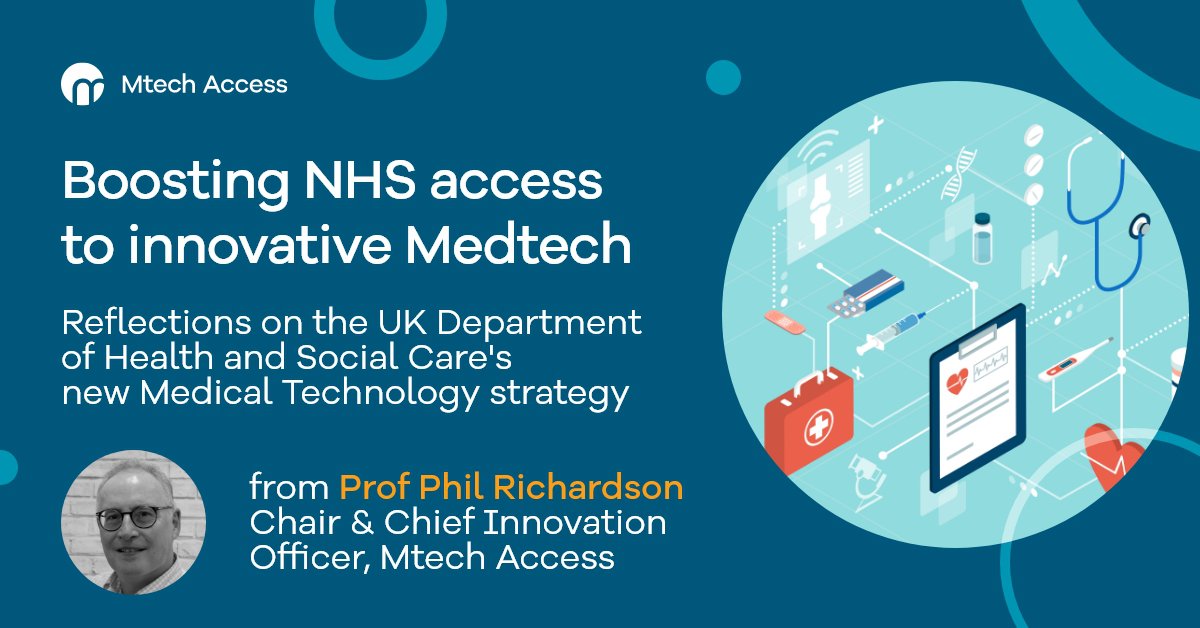
Today (3rd February 2023) the UK Department of Health and Social Care launched a new strategy to boost NHS access to innovative medical technology. Prof Phil Richardson (Chair and Chief Innovation Officer, Mtech Access) shares his thoughts and reflections on the new policy.
The new Medtech strategy gives industry and health systems permission to make a difference
The publication of the Medical Technology Strategy today reinforces the importance of Medtech solutions to the future delivery of safe and effective healthcare for patients. Recognising the material contribution that Medtech innovation made during the height of the Covid pandemic, the strategy sets out a clear direction for the diverse products and services that form the Medtech industry.
As a vital industry for the UK economy, Medtech not only underpins care, but it also enables economic and social growth. The Medtech strategy aligns well with the fourth purpose of the Integrated Care System (ICS).
Medtech is innovation in practice. From plasters through to digital solutions, the industry brings a wealth of research and development into solutions that provide improved care. However, the pathway to patients has not been as well-defined as that for the pharmaceutical industry. Some technologies can take 7 or more years to get into the right hands, at the right time, and at the right price.
Navigating health systems, the national processes, regulatory requirements, clinical preferences and commissioning policies needs plenty of momentum, a navigation buddy, and an ability to quench an insatiable thirst for more data. This is a challenge for any innovator and can be particularly frustrating without the scale of resource to take on a fragmented behemoth.
The strategy’s 4 priority areas all make sense. Particularly when examined below the main, headline priority. Of course there is a shared responsibility to ensure resilience of supply, to adopt clinical and technical leadership, and to build a relationship with industry that is based on data.
The strategy offers clarity about markets, about Medtech in the community, in diagnostics, and in diagnosis closer to the patient; and digital and technological transformation seem to favour digitally-enabled solutions.
It will hopefully all become more clear when the proposed Medtech Directorate forms; although, having one central organisation seems to counter the move in the ICS strategy of place-based commissioning and provider collaborates. It's not yet clear how that will work. When you then overlay the life sciences strategy and the industrial strategy, a pattern suggesting centralisation emerges… Along with a clamour for industry to get access to the new directorate.
Work will be needed by clinical and digital leads in each of the systems to help figure out the ‘Right Product’ and ‘Right Place’ elements of the strategy. It is a great opportunity to underpin a local health inequalities strategy with the Right Product – particularly when the current model is disconnected.
Demand from systems based on patients’ needs should drive the priorities further. This must guide the workload for the Medtech directorate. It offers a bottom-up, evidenced-based, needs-led approach that could provide an excellent basis for industry collaborators to co-create solutions that drive outcomes for patients.
The strategy recognises the strengths of the Medtech industry and rightly highlights its importance for patients, communities and the national economy. To get the best start, industry needs to rethink what it means by market access – perhaps we should be thinking more in terms of patient access? Rather than the health economics of products, is it time to explore the health economics of collaborative solutions. Launch plans and market landscapes miss the dynamics of the emerging marketplace. This will challenge both health systems and industry. Networks of expertise need facilitating intelligently and new whole-system models need to work through local scenarios.
There must be a vital role for Academic Health Science Networks (AHSNs) and a need to bring the work that the Applied Research Collaboratives do further into the light. R&D becomes a front office function, and the capability to join-the-dots will be a much sought after skill. There will be a lot of sorting out of supply chains, approvals, language, responsibilities, and the need for consequential change programmes in all stakeholders for this strategy to work.
This strategy is neither medical or technical; it is about change of behaviour, change of priorities, and a focus on codifying what flashed into view during the pandemic. The implementation plan is promised. Why wait? The strategy exists! Get together and show how transformative Medtech can really be.
To learn more about our expertise in Medtech market (patient!) access or to explore the ramifications of this policy with Phil Richardson and our expert team, please email info@mtechaccess.co.uk.


